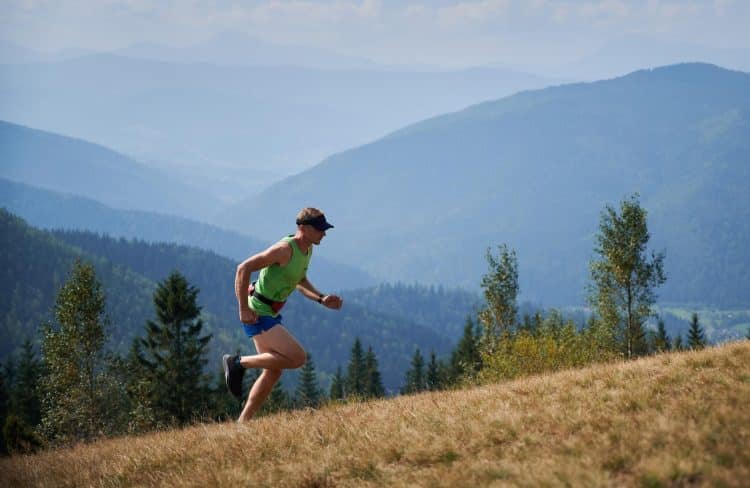Cardio is good for everybody’s body. Activities like moderate-paced running, cycling, swimming, and rowing can improve cardiovascular (heart, lung, and circulatory system) health (1). Cardio also provides protection against various diseases, including diabetes, hypertension, and even some cancers (1).
However, cardio, especially of the “Zone 2” variety, can be time-consuming, and some exercisers even find it boring. That’s especially true for lifters, who are usually more accustomed to more dynamic, faster-paced workouts. After all, the famous saying is “go hard, or go home,” not “go slow, or go home!”
I do plenty of cardio each week because the benefits outweigh the drawbacks. It’s also a cornerstone of my clients’ training, although it’s not something I typically supervise directly. I usually set cardio as homework that they can do in their own time. However, many tell me that it feels like medicine; they do it for its effects rather than enjoyment.
One way to make cardio more time-efficient and potentially enjoyable is to replace some of your slower-paced workouts with sprinting. Sprint workouts are challenging, intense, and fun.
In this article, I share some thoughts on sprinting, outlining the pros and cons of this type of training, and share some awesome sprint workouts you can try.
What is Sprinting?

Level Up Your Fitness: Join our 💪 strong community in Fitness Volt Newsletter. Get daily inspiration, expert-backed workouts, nutrition tips, the latest in strength sports, and the support you need to reach your goals. Subscribe for free!
Unless you are actively involved in sports, you probably don’t do a lot of sprinting. In fact, other than if your life is in danger or there is some sort of emergency, it’s rare that any of us ever have to sprint anymore.
That’s because true sprinting involves running as fast as you can.
Wind the clock back to when humans were hunters and gatherers, and sprinting was something we did out of necessity. It was a valuable skill for evading threats and catching food. Being fast on your feet was an evolutionary benefit; call it survival of the fastest!
However, the life of modern-day humans is much less physically stressful. As such, we no longer need to sprint to catch our dinner or escape from predators. Because of this, what most people call sprinting is actually fast running. Athletes still sprint, but for the rest of us, running at top speed is a lost art.
So, for the purpose of this article, sprinting means running like your life depends on it. In other words, covering the ground as fast as you can.
Sprinting and The Energy Systems
Your body runs on a chemical called Adenosine Triphosphate. Known as ATP for short, this substance is the energy currency of the human body. ATP comprises one adenosine molecule and three phosphate molecules. As it breaks down, the bonds holding ATP together release a burst of energy.
We make ATP in one of three ways…
The aerobic system uses fats and glucose in an oxygen-rich environment to make ATP. With lots of stored body fat available for fuel, the aerobic system can produce almost unlimited amounts of energy. The aerobic system is most active during periods of low-intensity activity.
In contrast, the lactate system produces ATP from glucose in an oxygen-free environment. This results in several metabolic by-products, not least hydrogen ions and lactate. Rising levels of these substances halt ATP production, and you’ll eventually have to slow down or stop so the aerobic system can take over.
The lactate system is most active during high-intensity activities, such as longer sprints, moderate to high-rep strength training, and start/stop field sports, e.g., soccer. It lasts between 30-90 seconds, depending on activity intensity.
The ATP/CP or anaerobic alactic energy system relies on the ATP stored in your muscles that’s available for instant use. We only have very limited ATP stores, so this system doesn’t last long. Typically, at maximum intensity, the ATP/CP system only lasts about ten seconds.
Sprinting is an ATP/CP dominant activity. However, longer sprints also involve the lactate system. To perform repeated sprints, you must rest long enough for ATP/CP stores to regenerate and lactate levels to decrease.
Summary: Sprinting involves running at top speed for relatively short durations, typically 10-30 seconds. Sprint workouts target the anaerobic alactic and lactate energy systems, where your body uses or makes ATP in an oxygen-free environment.
The Benefits of Sprint Workouts
Is sprinting the right workout for you and your goals? Consider these benefits and then decide!
More Time-Efficient Workouts
Compared to low-intensity steady state (LISS) cardio, sprint workouts are very short. You can get a good training effect from as little as 20-30 minutes, and some sprint workouts are even shorter. This makes sprint training ideal for time-pressed exercisers and those who find longer workouts unappealing or boring.
Improved Anaerobic and Aerobic Fitness
As you’d expect, anaerobic sprint workouts improve anaerobic fitness. Adaptations include larger ATP/CP stores, more rapid ATP/CP regeneration, improved resistance to fatigue, faster lactate removal, and quicker recovery between sprints.
However, a study published on PubMed also indicates that anaerobic training increases aerobic fitness (2). It also offers many of the health benefits more commonly associated with aerobic exercise.
Increases in Muscle Power, Strength, and Size
Max-effort sprints emphasize your type 2b or fast-twitch muscle fibers. These are the same fibers you target during strength training. As such, a sprint workout can potentially cause increases in muscle power, strength, and size (3).
However, it’s worth noting that these are merely side effects of sprint training and are not usually the main aim. If you want to specifically increase muscle power, strength, and size, you’ll probably get a better training effect from lifting weights.
Increased Speed
According to the fitness principle of specificity, the type of training you do determines how your body adapts and changes. Therefore, it makes sense that regular sprint training will make you a better sprinter.
While maximal sprinting speed is largely the result of genetic factors such as dominant muscle fiber type, it is also trainable. While you may never break ten seconds for the 100 meters, sprint workouts will make you faster.
Calorie and Fat Burning
Sprint workouts can help you manage your weight and lose fat in two ways. Firstly, sprinting burns a lot of calories. It’s a very intense activity that involves generating a lot of force with multiple muscles. It’s virtually a full-body activity. As such, sprinting burns many more calories per minute than a lower-paced workout.
Secondly, sprint workouts trigger Excess Post-Exercise Oxygen Consumption, or EPOC for short. EPOC describes how your metabolism goes into overdrive after a sprint session (4). Your body uses oxygen and energy to remove metabolic waste products and recover from the effects of your workout. The EPOC effect can last as long as 48 hours.
These two factors, when you combine them with a sensible diet, can help you lose weight and get lean. This is despite sprint workouts being shorter and not in the so-called “fat-burning zone.”
Summary: Sprint workouts are time-efficient, increase anaerobic and aerobic fitness, increase muscle power, strength, and size, make you faster, and can help you get lean. That’s a lot of benefits for a relatively short workout!
Sprint Workout Drawbacks
While sprint training can be very effective, there are a few drawbacks to consider, too. These include:
Increased Risk of Injury
A maximal speed sprint is like doing a one-repetition maximum lift in the gym. It pushes your body to its limits and could easily result in injury. Common sprinting injuries include pulled/strained muscles, joint pain, and other impact-related issues.
You can reduce your risk of injury by warming up thoroughly before each workout and not going too fast too soon. Novice sprinters should avoid going at full speed until they’re physically ready. Several months of strength training and plyometrics (jump training) will help prepare your body for the demands of sprinting.
Lack of Space/Facilities
While you can do high-speed intervals on a treadmill, you cannot sprint. For starters, trying to run at top speed on a treadmill could be dangerous. One small trip would be disastrous! Secondly, treadmills don’t usually go fast enough to be considered sprinting.
Level Up Your Fitness: Join our 💪 strong community in Fitness Volt Newsletter. Get daily inspiration, expert-backed workouts, nutrition tips, the latest in strength sports, and the support you need to reach your goals. Subscribe for free!
Subsequently, most sprint workouts require a large, flat outdoor area. A running track is ideal, and a sports field comes a close second. At a stretch, you could use an empty parking lot or quiet street. Because of this, not everyone will have somewhere to sprint.
Sprinting is a Lost Skill for Many Exercisers
While I’ve described sprinting as running at top speed, there’s actually more to it than this. Elite sprinters spend their entire careers mastering and refining their sprinting technique. Many of these athletes began sprinting back in high school or even earlier.
It’s beyond the scope of this article to teach you how to sprint, but there are plenty of resources you can use to coach yourself. Here’s a video to get you started:
Summary: Sprinting is an acquired skill that can be hard on your body. It could cause injuries, especially if you are not adequately prepared. Sprint workouts may be too intense for beginners. You’ll also need a suitable space to sprint safely.
The Best Sprint Workouts for Speed, Fitness, and Fat Loss
Now you know the benefits, pros, and cons of sprinting, it’s time to lace up your running shoes and try some sprint workouts. But, before you begin, make sure you prepare your body for what you are about to do with an appropriate warm-up. After all, sprinting is a max-effort activity.
Your warm-up should include:
- Pulse raiser – 5-10 minutes of easy jogging to raise your core temperature.
- Dynamic mobility and flexibility exercises – to prepare your joints and muscles.
- Running drills – including exercises like quick feet, butt kickers, and high knees
- Strides – 3-5 progressively faster sprints (60-80% speed) to prepare your body for your coming workout.
Ready? Then let’s begin!
1. Broken 100s
I came up with this workout when I wanted to do 100-meter sprints but didn’t have enough space. It’s since become one of my favorite sprint workouts. Broken 100s are so-called because the distance is divided into smaller sections.
How to do it:
Place five cones five meters apart, as shown below.
1—–2—–3—–4—–5
Starting at the first cone, sprint out to cone #2 and back to the start. Immediately turn and sprint out to cone #3 and back. Repeat this twice more by sprinting out to cone #4 and, finally, #5. Sprint back to the start and rest. Congratulations, you have just sprinted 100 meters!
Rest for two minutes and repeat. Do 5-8 broken 100-meter sprints in total.
2. Track Sprint/Walk Intervals
You’ll need a running track for this workout, although you could also do it on a large sports field. This sprint training session will develop your speed endurance and anaerobic conditioning. It’ll also burn lots of calories and trigger a massive EPOC effect. However, it’s pretty tough, so feel free to modify it based on your fitness.
How to do it:
After your warm-up, sprint the straight of your track and then walk the bend. Walk slowly so you are mostly recovered when you reach the next straightaway. Repeat this sequence until you have completed four laps/eight sprints.
3. ATP/CP Sprints
This workout will improve your maximal speed and develop your anaerobic alactic fitness. It won’t tire you out like some other sprint workouts, as the focus is on work quality rather than quantity. However, you should try to sprint at top speed, so this is still an intense workout.
How to do it:
Using a rolling start*, sprint as fast as possible for ten seconds. Make a note of how far you travel. For example, drop a stone at the end of your sprint. Walk slowly for 2-3 minutes to recover, and then repeat. Do 4-8 sprints in total. End your workout sooner if you notice that you are covering less distance per sprint.
*A rolling start is where you jog and then run a few meters before starting your sprint. This allows you to hit top speed right at the start of your work interval. Rolling starts are also easier on your joints and muscles and may help prevent injuries. Use rolling starts whenever practical.
4. Hill Sprints for Speed and Power
While sprinting uphill is invariably harder than on the flat, it’s also much better for your joints. The incline means the ground comes up to meet your feet a little sooner, reducing the impact. Hill sprints are a good option for older exercisers and anyone with lower limb issues.
How to do it:
Find a short, steep hill that’s about 30-50 meters long. Ideally, it should take you no more than 20 seconds to ascend it. Leaning into the hill, sprint up the hill as fast as you can. Drive your knees up and your elbows back to maximize your speed.
On reaching the top, accelerate and continue to sprint for a few more seconds. Stop and casually walk back down to the start. Rest for 2-3 minutes, and then repeat. Do 5-8 sprints in total. End your workout sooner if you notice that you are slowing down before reaching the top.
5. Hill Sprints for Fitness and Fat Loss
This workout will overload your lactate system to burn calories, maximize EPOC, and develop your fitness and work capacity. Unlike some other workouts in this article, hill sprints for fitness and fat loss involve incomplete recoveries, making them feel much more intense. Expect to feel very tired during and after this workout.
How to do it:
Find a long, gradual hill. Ideally, it should take you 45-60 seconds to ascend it. Very fit individuals can use longer hills, up to 90 seconds. After your warm-up, sprint up the hill as fast as possible. Lean into the slope, pump your arms, and drive with your legs.
On reaching the top, turn around and walk or jog back to the bottom. Rest no longer than twice the time it took you to sprint up the hill. Repeat this sequence 6-10 times. Because your rests are not long enough for full recovery, expect your speed to decrease from one rep to the next.
Read also: Speed Training Plan: How to Run Faster
Closing Thoughts
Sprinting is not for everyone. After all, it’s a maximal effort, high-impact activity that can be tough on your muscles and joints. Sprint-related injuries are not uncommon. Also, depending on the type of sprint workout you perform, it can be very challenging for your heart and lungs.
However, in terms of bang for your buck, sprint workouts are hard to beat. They can build aerobic and anaerobic fitness, develop your muscles, improve your speed, and help you get lean. Sprint workouts are short, so they’re perfect for time-pressed exercisers.
The best way to determine if sprinting is a good workout for you is to try it. I’ve provided you with five different workouts to get you started, and you can also design your own.
But remember, sprinting is a skill, and it may take you a while to learn (or relearn) how to do it. So, take it easy at first, and increase your speed and training volume gradually. Doing too much too soon is a recipe for injury and overtraining.
References:
- Franklin BA, Eijsvogels TMH, Pandey A, Quindry J, Toth PP. Physical activity, cardiorespiratory fitness, and cardiovascular health: A clinical practice statement of the ASPC Part I: Bioenergetics, contemporary physical activity recommendations, benefits, risks, extreme exercise regimens, potential maladaptations. Am J Prev Cardiol. 2022 Oct 13;12:100424. doi: 10.1016/j.ajpc.2022.100424. PMID: 36281324; PMCID: PMC9586848.
- Rakobowchuk M, Tanguay S, Burgomaster KA, Howarth KR, Gibala MJ, MacDonald MJ. Sprint interval and traditional endurance training induce similar improvements in peripheral arterial stiffness and flow-mediated dilation in healthy humans. Am J Physiol Regul Integr Comp Physiol. 2008 Jul;295(1):R236-42. doi: 10.1152/ajpregu.00069.2008. Epub 2008 Apr 23. PMID: 18434437; PMCID: PMC2494806.
- Nuell S, Illera-Domínguez VR, Carmona G, Alomar X, Padullés JM, Lloret M, Cadefau JA. Hypertrophic muscle changes and sprint performance enhancement during a sprint-based training macrocycle in national-level sprinters. Eur J Sport Sci. 2020 Jul;20(6):793-802. doi: 10.1080/17461391.2019.1668063. Epub 2019 Sep 26. PMID: 31526116.
- Tucker WJ, Angadi SS, Gaesser GA. Excess Post-exercise Oxygen Consumption After High-Intensity and Sprint Interval Exercise, and Continuous Steady-State Exercise. J Strength Cond Res. 2016 Nov;30(11):3090-3097. doi: 10.1519/JSC.0000000000001399. PMID: 26950358.











